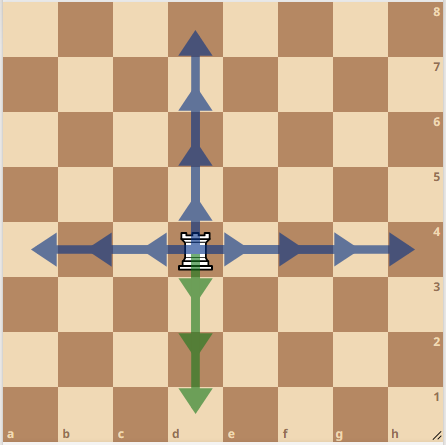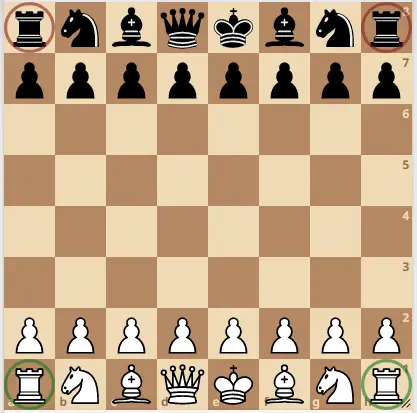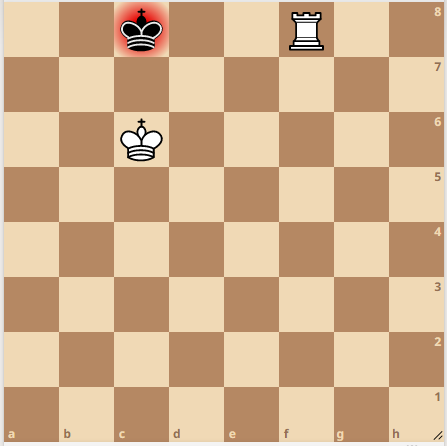If you’re still learning the strategies and rules of chess, you might ask yourself: Can a rook move backward in chess?
The simple answer is yes. You can move the rook backward as long as there’s no other piece blocking the pathway of movement. That’s because, unlike the knight, the rook can’t jump over other pieces during its movement.
Moving the rook is a simple concept to learn in chess and it’s really not that complicated. This article will help you understand the movement of the rook so that you can progress further in your chess journey. Understanding how the pieces move is critical if you wish to master the game of chess. With that said, let’s jump right in.
Can a Rook Move Backward in Chess?
Yes, during a chess game, you can move your rook backward, forward, or sideways. You can move your rook one square backward or up to seven squares backwards at a time until it reaches an obstacle or until it captures an opponent’s piece.
Rook can move backward as indicated by the green arrows

Rooks are the second most powerful piece on the chess board, not just because they have the ability to move backwards, but because they are long ranged pieces. The can move across the chess board from one end to the other very swiftly unlike the knight, king or pawns which are restricted to a limited number of squares at a time.
You can use your rook to defend or control a certain area as well as attack certain pieces. You can use your rooks to control files down the board or cut off the enemy king from accessing key squares in the position.
Your rook can also partake in a special move with the king known as castling. In castling, the king move 2 squares towards the rook in the corner, then the rook jumps over the king and lands beside it. Castling is the only time in which you can move 2 of your pieces in a single move. Furthermore, you can execute this move from the king’s side or the queen’s side depending on the nature of the position.
When Can the Rook and the King Do Castling?
There are four conditions for this move to be legal:
- Both the king and the rook shouldn’t have moved since the start of the game.
- There should be no friendly or enemy pieces in the path of movement of both pieces.
- You can’t carry out this movement if the king is currently being checked. Once you clear the check, you can proceed with the move.
- The movement will also fail if there’s any opposing piece attacking any squares along the path of the movement.
For more information on castling, see article: How to castle in chess app?
What Are the General Movements of the Rook?
You can move your rook as many squares as you would like as long as it doesn’t stumble upon an occupied square. That’s why the most effective way to place a rook is on open or semi-open files.
The rook captures other pieces by moving to the squares they occupy. However, it can’t jump over other pieces as a knight does.
So, if it’s in a blocked position, like at the beginning of the game, it can’t move.
Rooks in their initial position cannot move backwards or anywhere frankly as they are stuck behind their own pieces

Is It a Good Move to Move My Rook Backward?
Just because a specific move is valid and allowed in chess doesn’t mean that it’s a good move. More often than not, moving your rook backward isn’t a sign that you’re on top of the game (from a beginner point of view)
Moving your rook backward is not a move to be frowned upon.However, if you’re not doing it with a clear plan in mind, you should think twice.
Generally speaking, it’s better to use your rook to attack or apply pressure along an entire pathway of squares. For example, you could use your rook to add pressure on your opponent’s weak pawn or square along an open file.
How to Decide Whether It’s Good to Move My Rook Backward?
It takes a little practice to understand when would be a good time to move your rook backward. You can move your rook backward to safeguard your king on the backrank so that it doesn’t get checkmate. You can also move your rook backward to attack an enemy piece or carry out a strategic winning idea.
Generally, you want to move your rooks all the way up the board, especially to the 7th ranks (2nd rank for white). The further your rooks are into enemy territory, the better your attacking chances. Advancing your 2 rooks to the 7th rank of the chess board is even more destructive for your opponent.
All in all, rooks must move up the board instead of backwards. Generally, it is a bad sign when you move your pieces backwards. Your pieces must be participating in the game which is most likely in the center or in your opponent’s half of the board.
What Are the Possible Checkmates With a Rook?
There are three common ways to achieve checkmate with your rook: the single rook mate, the double-rook mate, and the backrank mate.
Single Rook Mate

You can checkmate the opponent with a rook and a king alone. This happens when:
- Your opponent’s king is on the 8th row and so is your rook.
- Your king is on the 6th row on the same vertical line as the opponent’s king.
Double-Rook Mate

Checkmate with two rooks happens when the following conditions are met:
- Your opponent’s king is on a horizontal line where it can’t move backward.
- One of your rooks is on the same horizontal line as the king.
- Your other rook is on the horizontal line that’s below the one on which your first rook and opponent’s king are standing.
Back Rank Mate

The back rank mate is achievable when the following happens:
- Your opponent’s king is in a position where they can’t move forward or backward.
- Your rook stands on the same horizontal plane as the opponent’s king.
FAQs
What Are the Chess Pieces That Can Move Backward?
Any chess piece can move backward except the pawns. So, your King, Queen, Bishops, Rooks, and Knights can all move backward.
What Does It Mean When a Rook Castles With the King?
Castling is an exceptional case in chess where two pieces move at the same time. It’s also the only instance where other pieces than the knight can move over another piece.
What happens is that the king moves two spaces, either to the left or to the right. Then, the rook moves in front of the king to provide protection or “castle” the king.
What’s the Rook’s Rank In the Game?
The rook is one of the major pieces in chess as it’s worth five points. To put things in perspective, the knight and the bishop are worth three points, the queen is worth nine, and the pawn is worth one point.
Final Thoughts
So, now that you know the nitty gritty that’s related to how rooks move in chess, we hope that you’re closer to devising the perfect strategy.
Remember to use the rook moving backward rule to your strategic advantage, and to do so correctly.
Knowing the rules of the game is essential for all chess players, so make sure you understand them before you start playing!


